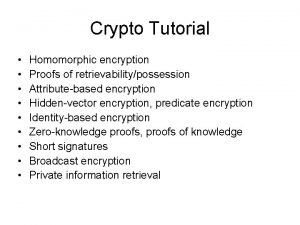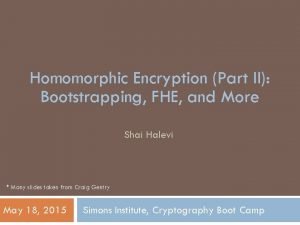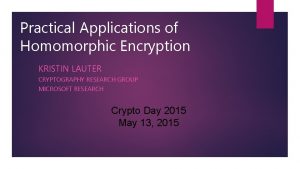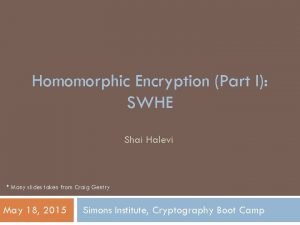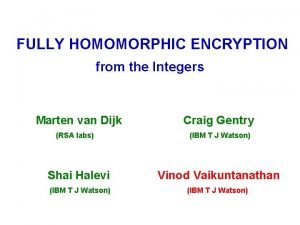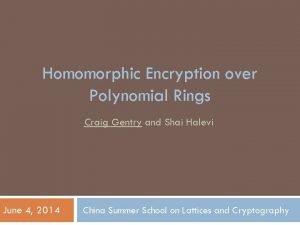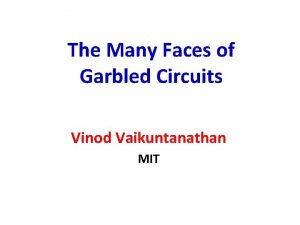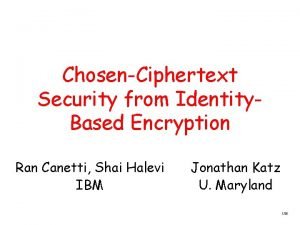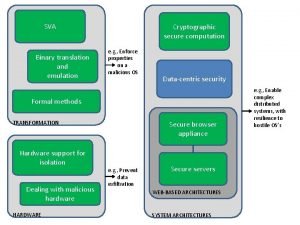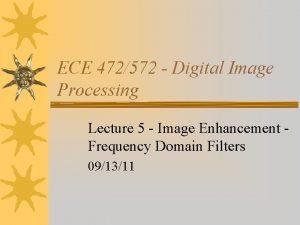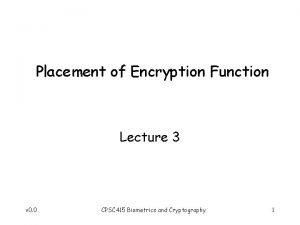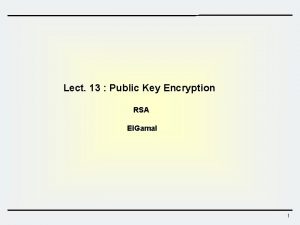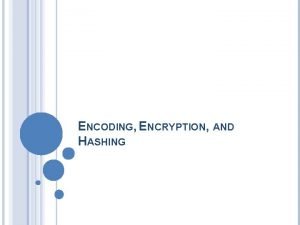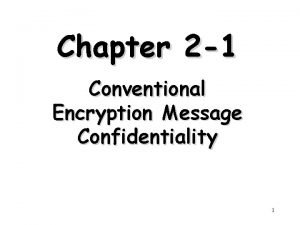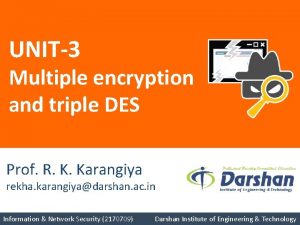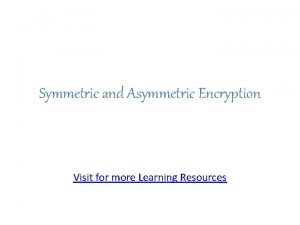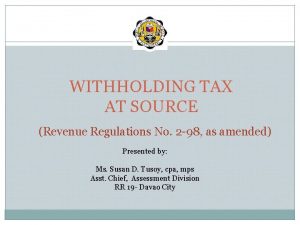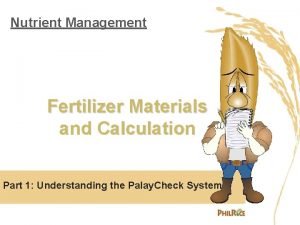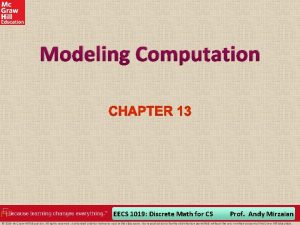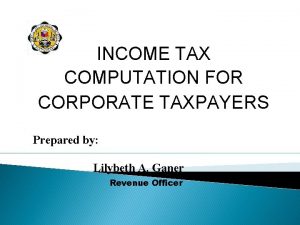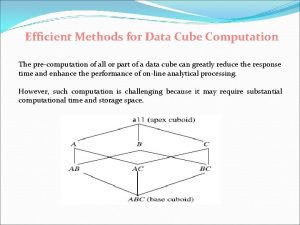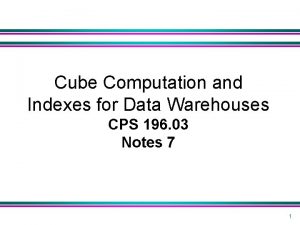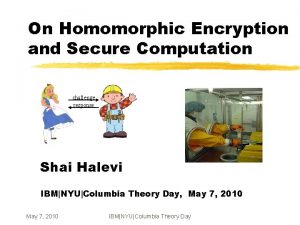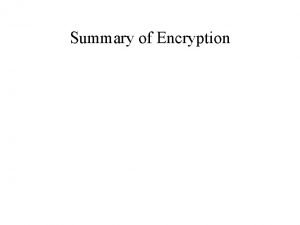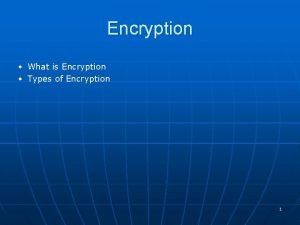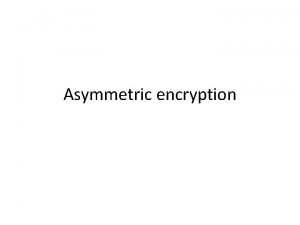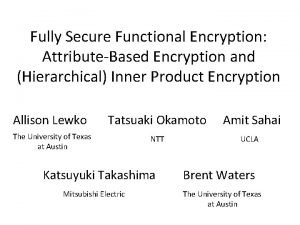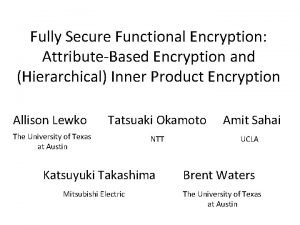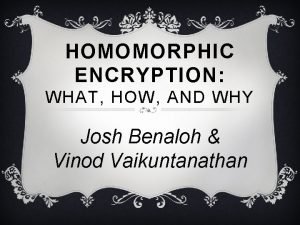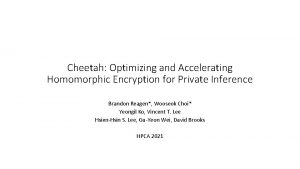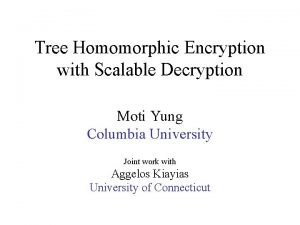On Homomorphic Encryption and Secure Computation challenge response






![Privacy Homomorphisms [RAD 78] Plaintext space P x 1 x 2 ci Enc(xi) Ciphertext Privacy Homomorphisms [RAD 78] Plaintext space P x 1 x 2 ci Enc(xi) Ciphertext](https://slidetodoc.com/presentation_image_h2/61ca87e0555cd8d0bd3db944a63d0394/image-7.jpg)
![More Privacy Homomorphisms o Mult-mod-p [El. Gamal’ 84] o Add-mod-N [Pallier’ 98] o Quadratic-polys More Privacy Homomorphisms o Mult-mod-p [El. Gamal’ 84] o Add-mod-N [Pallier’ 98] o Quadratic-polys](https://slidetodoc.com/presentation_image_h2/61ca87e0555cd8d0bd3db944a63d0394/image-8.jpg)



![(x, +)-Homomorphic Encryption, the [Gentry 09] blueprint Evaluate any function in four “easy” steps (x, +)-Homomorphic Encryption, the [Gentry 09] blueprint Evaluate any function in four “easy” steps](https://slidetodoc.com/presentation_image_h2/61ca87e0555cd8d0bd3db944a63d0394/image-12.jpg)


![An Example: Integers mod p (similar to [Regev’ 03]) p N o Code determined An Example: Integers mod p (similar to [Regev’ 03]) p N o Code determined](https://slidetodoc.com/presentation_image_h2/61ca87e0555cd8d0bd3db944a63d0394/image-15.jpg)



![Instantiations o [Gentry ‘ 09] Polynomial Rings Ø Security based on hardness of “Bounded-Distance Instantiations o [Gentry ‘ 09] Polynomial Rings Ø Security based on hardness of “Bounded-Distance](https://slidetodoc.com/presentation_image_h2/61ca87e0555cd8d0bd3db944a63d0394/image-19.jpg)
![Step 3: Bootstrapping [G’ 09] o So far, can evaluate low-degree polynomials x 1 Step 3: Bootstrapping [G’ 09] o So far, can evaluate low-degree polynomials x 1](https://slidetodoc.com/presentation_image_h2/61ca87e0555cd8d0bd3db944a63d0394/image-20.jpg)
![Step 3: Bootstrapping [G’ 09] o So far, can evaluate low-degree polynomials x 1 Step 3: Bootstrapping [G’ 09] o So far, can evaluate low-degree polynomials x 1](https://slidetodoc.com/presentation_image_h2/61ca87e0555cd8d0bd3db944a63d0394/image-21.jpg)
![Step 3: Bootstrapping [G’ 09] o So far, can evaluate low-degree polynomials x 1 Step 3: Bootstrapping [G’ 09] o So far, can evaluate low-degree polynomials x 1](https://slidetodoc.com/presentation_image_h2/61ca87e0555cd8d0bd3db944a63d0394/image-22.jpg)
![Step 3: Bootstrapping [G’ 09] o Include in the public key also Encpk(sk) x Step 3: Bootstrapping [G’ 09] o Include in the public key also Encpk(sk) x](https://slidetodoc.com/presentation_image_h2/61ca87e0555cd8d0bd3db944a63d0394/image-23.jpg)
![Step 3: Bootstrapping [G’ 09] o Include in the public key also Encpk(sk) x Step 3: Bootstrapping [G’ 09] o Include in the public key also Encpk(sk) x](https://slidetodoc.com/presentation_image_h2/61ca87e0555cd8d0bd3db944a63d0394/image-24.jpg)


![Beyond the [G’ 09] Blueprint o [GH’ 11 b] no “squashing”, still very inefficient Beyond the [G’ 09] Blueprint o [GH’ 11 b] no “squashing”, still very inefficient](https://slidetodoc.com/presentation_image_h2/61ca87e0555cd8d0bd3db944a63d0394/image-27.jpg)


![Two-Message SFE [Yao’ 82, …] Alice(x) (c, s) SFE 1(x) y SFE 3(s, r) Two-Message SFE [Yao’ 82, …] Alice(x) (c, s) SFE 1(x) y SFE 3(s, r)](https://slidetodoc.com/presentation_image_h2/61ca87e0555cd8d0bd3db944a63d0394/image-30.jpg)






![A More Complex Setting: i-Hop HE [GHV’ 10 b] Alice(x) c 0 Enc(x) Bob(f) A More Complex Setting: i-Hop HE [GHV’ 10 b] Alice(x) c 0 Enc(x) Bob(f)](https://slidetodoc.com/presentation_image_h2/61ca87e0555cd8d0bd3db944a63d0394/image-37.jpg)






- Slides: 43

On Homomorphic Encryption and Secure Computation challenge response Shai Halevi June 16, 2011

Computing on Encrypted Data Wouldn’t it be nice to be able to… o Encrypt my data in the cloud o While still allowing the cloud to search/sort/edit/… this data on my behalf o Keeping the data in the cloud in encrypted form Ø Without needing to ship it back and forth to be decrypted June 16, 2011 2

Computing on Encrypted Data Wouldn’t it be nice to be able to… o Encrypt my queries to the cloud o While still allowing the cloud to process them o Cloud returns encrypted answers Ø that I can decrypt June 16, 2011 3

Computing on Encrypted Data Directions • From: Tel-Aviv University, Tel-Aviv, Israel • To: Technion, Haifa, Israel June 16, 2011 $skj#h. S 28 ksyt. A@ … 4

Computing on Encrypted Data $kjh 9*mslt@na 0 &ma. Xxjq 02 bflx m^00 a 2 nm 5, A 4. p. E. abxp 3 m 58 bsa (3 sa. M%w, snanba nq~m. D=3 akm 2, A Z, ltnhde 83|3 mz{n dewiunb 4]gnb. Ta* kjew^bw. J^mdns 0 June 16, 2011 5

Constructing Homomorphic Encryption
![Privacy Homomorphisms RAD 78 Plaintext space P x 1 x 2 ci Encxi Ciphertext Privacy Homomorphisms [RAD 78] Plaintext space P x 1 x 2 ci Enc(xi) Ciphertext](https://slidetodoc.com/presentation_image_h2/61ca87e0555cd8d0bd3db944a63d0394/image-7.jpg)
Privacy Homomorphisms [RAD 78] Plaintext space P x 1 x 2 ci Enc(xi) Ciphertext space C c 1 * y c 2 # y Dec(d) d Some examples: o “Raw RSA”: c xe mod N (x cd mod N) Ø x 1 e x x 2 e = (x 1 x x 2)e mod N o GM 84: Enc(0) R QR, Enc(1) R QNR (in ZN*) Ø Enc(x 1) x Enc(x 2) = Enc(x 1 x 2) mod N June 16, 2011 7
![More Privacy Homomorphisms o Multmodp El Gamal 84 o AddmodN Pallier 98 o Quadraticpolys More Privacy Homomorphisms o Mult-mod-p [El. Gamal’ 84] o Add-mod-N [Pallier’ 98] o Quadratic-polys](https://slidetodoc.com/presentation_image_h2/61ca87e0555cd8d0bd3db944a63d0394/image-8.jpg)
More Privacy Homomorphisms o Mult-mod-p [El. Gamal’ 84] o Add-mod-N [Pallier’ 98] o Quadratic-polys mod p [BGN’ 06] o Branching programs [IP’ 07] o Later, a “different type of solution” for any circuit [Yao’ 82, …] ØAlso NC 1 circuits [SYY’ 00] June 16, 2011 8

(x, +)-Homomorphic Encryption It will be really nice to have… o Plaintext space Z 2 (w/ ops +, x) o Ciphertexts live in an algebraic ring R (w/ ops +, x) o Homomorphic for both + and x Ø Enc(x 1) + Enc(x 2) in R = Enc(x 1+ x 2 mod 2) Ø Enc(x 1) x Enc(x 2) in R = Enc(x 1 x x 2 mod 2) o Then we can compute any function on the encryptions Ø Since every binary function is a polynomial o We won’t get exactly this, but it’s a good motivation June 16, 2011 9

Some Notations o An encryption scheme: (Key. Gen, Enc, Dec) ØPlaintext-space = {0, 1} Ø(pk, sk) Key. Gen($), c Encpk(b), b Decsk(c) o Semantic security [GM’ 84]: (pk, Encpk(0)) (pk, Encpk(1)) means indistinguishable by efficient algorithms June 16, 2011 10

Homomorphic Encryption o H = {Key. Gen, Enc, Dec, Eval} c* Evalpk(f, c) c* o Homomorphic: Decsk(Evalpk( f, Encpk(x))) = f(x) Ø c* may not look like a “fresh” ciphertext Ø As long as it decrypts to f(x) o Function-private: c* hides f o Compact: Decrypting c* easier than computing f Ø |c*| independent of the complexity of f June 16, 2011 11
![x Homomorphic Encryption the Gentry 09 blueprint Evaluate any function in four easy steps (x, +)-Homomorphic Encryption, the [Gentry 09] blueprint Evaluate any function in four “easy” steps](https://slidetodoc.com/presentation_image_h2/61ca87e0555cd8d0bd3db944a63d0394/image-12.jpg)
(x, +)-Homomorphic Encryption, the [Gentry 09] blueprint Evaluate any function in four “easy” steps o Step 1: Encryption from linear ECCs Ø Additive homomorphism o Step 2: ECC lives inside a ring Ø Also multiplicative homomorphism Ø But only for a few operations (i. e. , low-degree poly’s) o Step 3: Bootstrapping Ø Few ops (but not too few) any number of ops o Step 4: Everything else June 16, 2011 12

Step One: Encryption from Linear ECCs o For “random looking” codes, hard to distinguish close/far from code o Many cryptosystems built on this hardness ØE. g. , [Mc. Eliece’ 78, AD’ 97, GGH’ 97, R’ 03, …] June 16, 2011 13

Encryption from linear ECCs o Key. Gen: choose a “random” code C ØSecret key: “good representation” of C § Allows correction of “large” errors ØPublic key: “bad representation” of C o Enc(0): a word close to C o Enc(1): a random word ØFar from C (with high probability) June 16, 2011 14
![An Example Integers mod p similar to Regev 03 p N o Code determined An Example: Integers mod p (similar to [Regev’ 03]) p N o Code determined](https://slidetodoc.com/presentation_image_h2/61ca87e0555cd8d0bd3db944a63d0394/image-15.jpg)
An Example: Integers mod p (similar to [Regev’ 03]) p N o Code determined by an integer p ØCodewords: multiples of p o Good representation: p itself o Bad representation: ri << p ØN = pq, and also many xi = pqi + ri o Enc(0): subset-sum(xi’s)+r mod N o Enc(1): random integer mod N June 16, 2011 15

A Different Input Encoding o Both Enc(0), Enc(1) close to the code ØEnc(0): distance to code is even ØEnc(1): distance to code is odd o In our example of integers mod p: ØEnc(b) = 2(subset-sum(xi’s)+r) +b mod N ØDec(c) = (c mod p) mod 2 June 16, 2011 16

Additive Homomorphism o c 1+c 2 = (codeword 1+codeword 2) +2(r 1+r 2)+b 1+b 2 Øcodeword 1+codeword 2 Code ØIf 2(r 1+r 2)+b 1+b 2 < min-dist/2, then it is the dist(c 1+c 2, Code) = 2(r 1+r 2)+b 1+b 2 dist(c 1+c 2, Code) mod 2 = b 1+b 2 o Additively-homomorphic while close to Code June 16, 2011 17

Step 2: ECC Lives in a Ring R o What happens when multiplying in R: Øc 1 c 2 = (codeword 1+2 r 1+b 1) x (codeword 2+2 r 2+b 2) = codeword 1 X + Y codeword 2 + (2 r 1+b 1)(2 r 2+b 2) o If: Code is an ideal Øcodeword 1 X + Y codeword 2 Code Product in R of small Ø (2 r 1+b 1)(2 r 2+b 2) < min-dist/2 o Then elements is small Ødist(c 1 c 2, Code) = (2 r 1+b 1)(2 r 2+b 2) = b 1 b 2 mod 2 June 16, 2011 18
![Instantiations o Gentry 09 Polynomial Rings Ø Security based on hardness of BoundedDistance Instantiations o [Gentry ‘ 09] Polynomial Rings Ø Security based on hardness of “Bounded-Distance](https://slidetodoc.com/presentation_image_h2/61ca87e0555cd8d0bd3db944a63d0394/image-19.jpg)
Instantiations o [Gentry ‘ 09] Polynomial Rings Ø Security based on hardness of “Bounded-Distance Decoding” in ideal lattices o [v. DGHV ‘ 10] Integer Ring Ø Security based on hardness of the “approximate. GCD” problem o [GHV ‘ 10] Matrix Rings* Ø Only degree-2 polynomials, security based on hardness of “Learning with Errors” o [BV ‘ 11 a] Polynomial Rings Ø Security based on “ring LWE” June 16, 2011 19
![Step 3 Bootstrapping G 09 o So far can evaluate lowdegree polynomials x 1 Step 3: Bootstrapping [G’ 09] o So far, can evaluate low-degree polynomials x 1](https://slidetodoc.com/presentation_image_h2/61ca87e0555cd8d0bd3db944a63d0394/image-20.jpg)
Step 3: Bootstrapping [G’ 09] o So far, can evaluate low-degree polynomials x 1 x 2 … P P(x 1, x 2 , …, xt) xt June 16, 2011 26
![Step 3 Bootstrapping G 09 o So far can evaluate lowdegree polynomials x 1 Step 3: Bootstrapping [G’ 09] o So far, can evaluate low-degree polynomials x 1](https://slidetodoc.com/presentation_image_h2/61ca87e0555cd8d0bd3db944a63d0394/image-21.jpg)
Step 3: Bootstrapping [G’ 09] o So far, can evaluate low-degree polynomials x 1 x 2 … P P(x 1, x 2 , …, xt) xt o Can eval y=P(x 1, x 2…, xn) when xi’s are “fresh” o But y is an “evaluated ciphertext” ØCan still be decrypted ØBut eval Q(y) will increase noise too much June 16, 2011 27
![Step 3 Bootstrapping G 09 o So far can evaluate lowdegree polynomials x 1 Step 3: Bootstrapping [G’ 09] o So far, can evaluate low-degree polynomials x 1](https://slidetodoc.com/presentation_image_h2/61ca87e0555cd8d0bd3db944a63d0394/image-22.jpg)
Step 3: Bootstrapping [G’ 09] o So far, can evaluate low-degree polynomials x 1 x 2 … P P(x 1, x 2 , …, xt) xt o Bootstrapping to handle higher degrees: o For ciphertext c, consider Dc(sk) = Decsk(c) ØHope: Dc(*) is a low-degree polynomial in sk ØThen so are Ac 1, c 2(sk) = Decsk(c 1) + Decsk(c 2) and Mc 1, c 2(sk) = Decsk(c 1) x Decsk(c 2) June 16, 2011 28
![Step 3 Bootstrapping G 09 o Include in the public key also Encpksk x Step 3: Bootstrapping [G’ 09] o Include in the public key also Encpk(sk) x](https://slidetodoc.com/presentation_image_h2/61ca87e0555cd8d0bd3db944a63d0394/image-23.jpg)
Step 3: Bootstrapping [G’ 09] o Include in the public key also Encpk(sk) x 1 c 1 sk 2 … skn June 16, 2011 x 2 c 2 Requires “circular security” Mc 1, c 2 c Mc 1, c 2(sk) = Decsk(c 1) x Decsk(c 2) = x 1 x x 2 29
![Step 3 Bootstrapping G 09 o Include in the public key also Encpksk x Step 3: Bootstrapping [G’ 09] o Include in the public key also Encpk(sk) x](https://slidetodoc.com/presentation_image_h2/61ca87e0555cd8d0bd3db944a63d0394/image-24.jpg)
Step 3: Bootstrapping [G’ 09] o Include in the public key also Encpk(sk) x 1 c 1 sk 2 … skn x 2 c 2 Requires “circular security” Mc 1, c 2 c Mc 1, c 2(sk) = Decsk(c 1) x Decsk(c 2) = x 1 x x 2 o Homomorphic computation applied only to the “fresh” encryption of sk June 16, 2011 30

Step 4: Everything Else o Cryptosystems from [G’ 09, v. DGHV’ 10, BG’ 11 a] cannot handle their own decryption o Tricks to “squash” the decryption procedure, making it low-degree June 16, 2011 31

Performance o Evaluating only low-degree polynomials may be reasonable o But bootstrapping is inherently inefficient ØHomomorphic decryption for each multiplication o Best implementation so far is [GH’ 11 a] ØPublic key size ~ 2 GB ØEvaluating a multiplication takes 30 minutes June 16, 2011 32
![Beyond the G 09 Blueprint o GH 11 b no squashing still very inefficient Beyond the [G’ 09] Blueprint o [GH’ 11 b] no “squashing”, still very inefficient](https://slidetodoc.com/presentation_image_h2/61ca87e0555cd8d0bd3db944a63d0394/image-27.jpg)
Beyond the [G’ 09] Blueprint o [GH’ 11 b] no “squashing”, still very inefficient o [BV’ 11 b] no underlying ring, only vectors ØAlso no “squashing”, but still inefficient o [G’ 11] no bootstrapping ØBuilds heavily on [BV’ 11 b] ØReduces noise “cheaply” after each multiplication ØShould be at least 2 -3 orders of magnitude better than [GV’ 11 a] June 16, 2011 33

Homomorphic Encryption vs. Secure Computation

Secure Function Evaluation (SFE) Client Alice has data x Server Bob has function f Alice wants to learn f(x) 1. Without telling Bob what x is 2. Bob may not want Alice to know f 3. Client Alice may also want server Bob to do most of the work computing f(x) June 16, 2011 35
![TwoMessage SFE Yao 82 Alicex c s SFE 1x y SFE 3s r Two-Message SFE [Yao’ 82, …] Alice(x) (c, s) SFE 1(x) y SFE 3(s, r)](https://slidetodoc.com/presentation_image_h2/61ca87e0555cd8d0bd3db944a63d0394/image-30.jpg)
Two-Message SFE [Yao’ 82, …] Alice(x) (c, s) SFE 1(x) y SFE 3(s, r) Bob(f) c r r SFE 2(f, c) o Many different instantiations are available Ø Based on hardness of factoring/DL/lattices/… o Alice’s x and Bob’s f are kept private o But Alice does as much work as Bob Ø Bob’s reply of size poly(n) x (|f|+|x|) June 16, 2011 36

Recall: Homomorphic Encryption o H = {Key. Gen, Enc, Dec, Eval} o Semantic security: (pk, Encpk(0)) (pk, Encpk(1)) c* o Homomorphic: Decsk(Evalpk( f, Encpk(x))) = f(x) Ø c* may not look like a “fresh” ciphertext Ø As long as it decrypts to f(x) o Function-private: c* hides f o Compact: Decrypting c* easier than computing f Ø |c*| independent of the complexity of f June 16, 2011 37

Aside: a Trivial Solution o Eval(f, c) = <f, c>, Dec*(<f, c>) = f (Dec(c)) o Neither function-private, nor compact o Not very useful in applications June 16, 2011 38

HE Two-Message SFE o Alice encrypts data x Øsends to Bob c Enc(x) o Bob computes on encrypted data Øsets c* Eval(f, c) Øc* is supposed to be an encryption of f(x) ØHopefully it hides f (function-private scheme) o Alice decrypts, recovers y Dec(c*) June 16, 2011 39

Two-Message SFE HE o Roughly: ØAlice’s message c SFE 1(x) is Enc(x) ØBob’s reply r SFE 2(f, c) is Eval(f, c) o Not quite public-key encryption yet ØWhere are (pk, sk)? ØCan be fixed with an auxiliary PKE scheme June 16, 2011 40

Two-Message SFE HE Alice(pk, Alice(x)x) (c, s) SFE 1(x) y SFE 3(s, r) Bob(f) Dora(sk) c r r SFE 2(f, c) o Add an auxiliary encryption scheme Øwith (pk, sk) June 16, 2011 41

Two-Message SFE HE Alice(pk, x) (c, s) SFE 1(x) c’ Encpk(s) Bob(f) Dora(sk) c, c’ Enc’pk(x) r SFE 2(f, c) Evalpk(f, c, c’) r, c’ s Decsk(c’) y SFE 3(s, r) Decsk(r, c’) o Recall: |r| could be as large as poly(n)(|f|+|x|) Ø Not compact June 16, 2011 42
![A More Complex Setting iHop HE GHV 10 b Alicex c 0 Encx Bobf A More Complex Setting: i-Hop HE [GHV’ 10 b] Alice(x) c 0 Enc(x) Bob(f)](https://slidetodoc.com/presentation_image_h2/61ca87e0555cd8d0bd3db944a63d0394/image-37.jpg)
A More Complex Setting: i-Hop HE [GHV’ 10 b] Alice(x) c 0 Enc(x) Bob(f) c 0 Charlie(g) c 1 Eval(f, c 0) c 1 c 2 Eval(g, c 1) Dora(sk) c 2 y Dec(c 2) 2 -Hop Homomorphic Encryption o c 1 is not a fresh ciphertext Ø May look completely different o Can Charlie process it at all? Ø What about security? June 16, 2011 43

Multi-Hop Homomorphic Encryption o H = {Key. Gen, Enc, Eval, Dec} as before o i-Hop Homomorphic (i is a parameter) x Encpk(x) c 0 Evalpk(f 1, c 0) c 1 Evalpk(f 2, c 1) c 2 … cj Decsk(x) y Any number j i hops Ø y = fj(fj-1(… f 1(x) …)) for any x, f 1, …, fj o Similarly for i-Hop function-privacy, compactness o Multi-Hop: i-Hop for any i June 16, 2011 44

1 -Hop multi-Hop HE o (Key. Gen, Enc, Eval, Dec) is 1 -Hop HE ØCan evaluate any single function on ctxt o We have c 1=Evalpk(f 1, c 0), and some other f 2 Bootstrapping: o Include with pk also c*=Encpk(sk) o Consider Fc , f (sk) = f 2( Decsk(c 1) ) 1 2 ØLet c 2=Evalpk(Fc , f , c*) 1 June 16, 2011 2 45

1 -Hop multi-Hop HE c* fi ci-1 sk xi-1 Fci-1, fi ci+1 Fc , f (sk) = fi( Decsk(ci-1) ) = fi(xi-1) i-1 i o Drawback: |ci| grows exponentially with i: Ø |Fc , f | |ci-1|+| fi| Ø |ci|= |Evalpk(Fc , f , c*)| poly(n)(|ci-1|+| fi|) i-1 i o Does not happen if underlying scheme is compact Or even |Evalpk(Fc June 16, 2011 i-1, fi , c*)| = |ci-1|+poly(n)| fi| 46

Other Constructions o Private 1 -hop HE + Compact 1 -hop HE Compact, Private multi-hop HE o A direct construction of multi-hop HE from Yao’s protocol June 16, 2011 47

Summary o Homomorphic Encryption is useful ØEspecially multi-hop HE o A method for constructing HE schemes from linear ECCs in rings ØTwo (+e) known instances so far o Connection to two-message protocols for secure computation June 16, 2011 48

Thank You
 Homomorphic encryption standard
Homomorphic encryption standard Homomorphic encryption tutorial
Homomorphic encryption tutorial Homomorphic encryption tutorial
Homomorphic encryption tutorial Craig gentry homomorphic encryption
Craig gentry homomorphic encryption Homomorphic encryption tutorial
Homomorphic encryption tutorial Gsw homomorphic encryption
Gsw homomorphic encryption Homomorphic encryption
Homomorphic encryption Somewhat homomorphic encryption
Somewhat homomorphic encryption Practical homomorphic encryption
Practical homomorphic encryption Swhe
Swhe Pq0p
Pq0p Craig gentry homomorphic encryption
Craig gentry homomorphic encryption Homomorphic encryption
Homomorphic encryption Skw vk
Skw vk Binary search in secure computation
Binary search in secure computation Secure multiparty computation
Secure multiparty computation Whitchester house
Whitchester house Homomorphic filtering block diagram
Homomorphic filtering block diagram Natural and forced response
Natural and forced response What is natural response
What is natural response A subsequent
A subsequent Explain about the placement of encryption function.
Explain about the placement of encryption function. Elgamal example
Elgamal example Encoding encryption and hashing
Encoding encryption and hashing Conventional encryption and message confidentiality
Conventional encryption and message confidentiality Modern block cipher in cryptography
Modern block cipher in cryptography Triple des advantages and disadvantages
Triple des advantages and disadvantages Advantages of asymmetric encryption
Advantages of asymmetric encryption W/tax compensation table
W/tax compensation table Expanded withholding tax computation
Expanded withholding tax computation Expanded withholding tax computation
Expanded withholding tax computation Expanded withholding tax computation
Expanded withholding tax computation Fertilizer computation philrice
Fertilizer computation philrice Eecs 1019
Eecs 1019 Sipser, m: introduction to the theory of computation
Sipser, m: introduction to the theory of computation How to compute for mcit
How to compute for mcit Income tax computation format
Income tax computation format Crystalloids and colloids examples
Crystalloids and colloids examples Individual tax computation format
Individual tax computation format Efficient methods for data cube computation
Efficient methods for data cube computation Drug calculation formula
Drug calculation formula Data cube computation
Data cube computation Index de computation
Index de computation Calculate drops per minute
Calculate drops per minute

